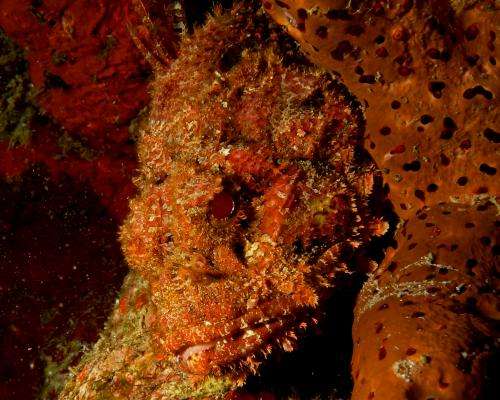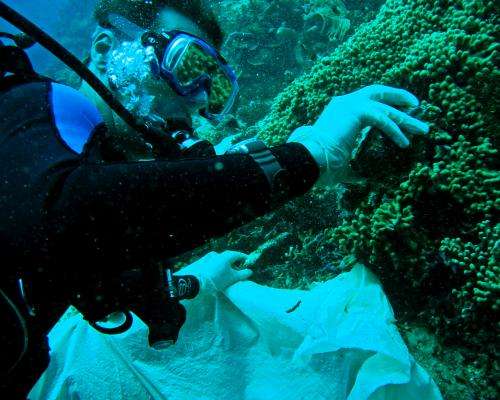A stone fish hiding behind a sponge. Credit: Benjamin Mueller
(Phys.org) —A team of researchers from the Netherlands has found that material sloughed off by sponges is eaten by organisms that live on or near coral reefs. In their paper published in the journal Science, the team describes experiments they conducted in their lab, then in the field to find out if sponges contribute to the survival of coral reef organisms by providing them with something to eat.
For many years scientists have wondered how it is that there is so much life on and around coral reefs—such areas are a virtual desert which begs the question, what are all the organisms eating? Prior research has found that bacteria in the water produce some nutrients, but not nearly enough to feed the wide variety of organisms found around coral reefs. Suspecting that sponges might provide some answers, the research team ran some experiments to find out if they are actually feeding those around them.
First, the team placed several sponges in a tank full of water, then fed them some sugar and a mixture of other material that held carbon and nitrogen in heavier than normal forms. Then they waited—sponges slough off detritus left over from meals they have consumed. Examining the detritus that covered the sponges, the researchers found evidence of the heavy nitrogen and carbon, indicating that the material the sponges were sloughing off was residue from food they had eaten.
Scientist Jasper de Goeij closing an underwater coral cavity. Credit: Benjamin Mueller
Next, the researchers moved to the ocean, specifically the coral reef off the island of Curaçao in the Caribbean. There they created a trap for several sponges living in cracks in the coral. Doing so allowed for keeping food in and also for collecting and measuring what the sponges were sloughing off. They fed the sponges the same kind of food as in the tank experiment then waited again. And once again, they found that the material sloughed off by the sponges had heavy carbon and nitrogen in it. They then waited a few more days before gathering some specimens of aquatic life living in the crack and found that they had measurable amounts of the heavy nitrogen and carbon in their tissues as well. This meant, of course, that they had eaten the material sloughed off by the sponges, and in so doing revealed at least one source of coral reef sustenance.
More information: Surviving in a Marine Desert: The Sponge Loop Retains Resources Within Coral Reefs, Science 4 October 2013: Vol. 342 no. 6154 pp. 108-110, DOI: 10.1126/science.1241981
ABSTRACT
Ever since Darwin's early descriptions of coral reefs, scientists have debated how one of the world's most productive and diverse ecosystems can thrive in the marine equivalent of a desert. It is an enigma how the flux of dissolved organic matter (DOM), the largest resource produced on reefs, is transferred to higher trophic levels. Here we show that sponges make DOM available to fauna by rapidly expelling filter cells as detritus that is subsequently consumed by reef fauna. This "sponge loop" was confirmed in aquarium and in situ food web experiments, using 13C- and 15N-enriched DOM. The DOM-sponge-fauna pathway explains why biological hot spots such as coral reefs persist in oligotrophic seas—the reef's paradox—and has implications for reef ecosystem functioning and conservation strategies.
Journal information: Science
© 2013 Phys.org























